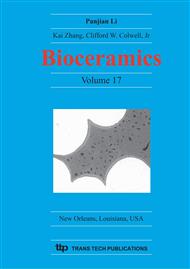p.701
p.705
p.709
p.713
p.717
p.721
p.725
p.729
p.733
Evaluations of a Novel Bioactive and Degradable Poly(Ɛ-Caprolactone) Hybrid Material Containing Silanol Group and Calcium Salt as a Bone Substitute
Abstract:
Bioactive poly(e-caprolactone)-siloxane hybrid material was newly developed and its in vitro and in vivo evaluations were made for the potential application as a bone substitute. The polymer precursor, triethoxysilane end capped poly(e-caprolactone) was prepared by the reaction with a,w-hydroxyl poly(e-caprolactone) and 3-isocyanatopropyl triethoxysilane with 1,4-diazabicyclo [2,2,2] octane as a catalyst and toluene as a solvent. The triethoxysilane end capped poly(e-caprolactone) was hydrolyzed and condensed to yield a hybrid sol-gel material. The gelation was carried out for 1 week at ambient condition in a covered Teflon mold with a few pinholes and then dried under vacuum at room temperature for 48 h. Its bioactivity was evaluated by examining the apatite formation on its surface in the SBF and its osteoconductivity was assessed in the tibia of white rabbit. The hybrid material showed apatite-forming ability in the SBF within 1 week soaking. Besides, new bone was formed on the surface of a cylindrical shaped specimen with no histologically demonstrable intervening non-osseous tissue after 6 weeks implantation. There was no evidence of inflammation or foreign body reaction. From the results, it can be concluded that this newly developed hybrid material has osteoconductivity and is likely to be used for the application as a bone graft substitute.
Info:
Periodical:
Pages:
717-720
Citation:
Online since:
April 2005
Authors:
Keywords:
Price:
Сopyright:
© 2005 Trans Tech Publications Ltd. All Rights Reserved
Share:
Citation:


